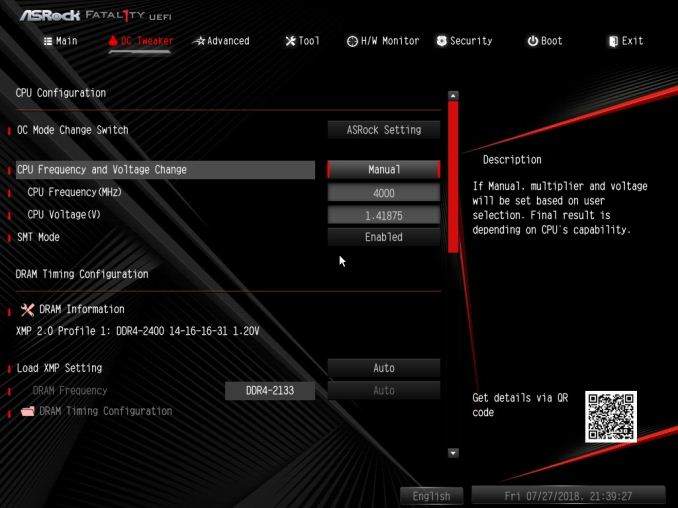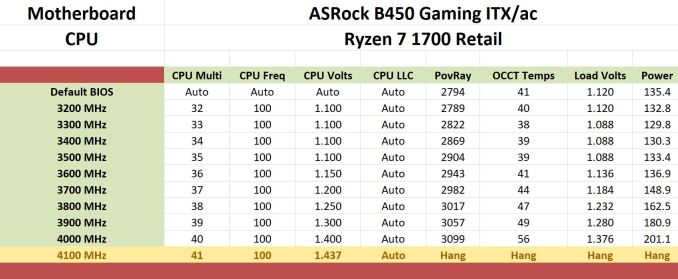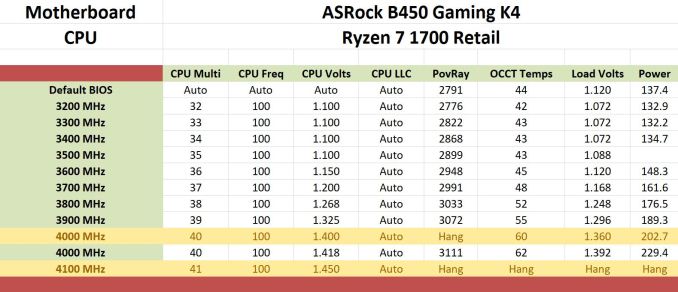The ASRock B450 Gaming ITX/ac and B450 Gaming K4 Motherboard Reviews
by Gavin Bonshor on July 31, 2018 10:00 AM ESTOverclocking
Overclocking with a Ryzen 7 1700 on ASRock's B450 Motherboards
As we have seen throughout our AM4 socket motherboard reviews, ASRock has generally performed quite well in the overclocking stakes; this is due to a combination of easy and user-friendly firmware. While not as overclocking focused as some of their other line-up such as the Taichi offerings which are some of the best the AMD side has to offer, not a lot of focus comes on overclocking from AMD, even though the more budget-focused B350 and B450 do openly support it. Our Ryzen 7 1700 sample at best does 4.0 GHz at around 1.375 to 1.400 V and a lot of it boils down to two things; the silicon quality of the processors die and the quality of the board's componentry.
The ASRock B450 BIOS remarkably resembles that of B350 and X370, albeit with minor visual differences to the theme which I believe is easier to look at, but this comes down to personal preference. The old adage reigns true with this particular firmware, 'if it’s not broken, don’t fix it', and that’s exactly what ASRock has done here. The BIOS is easy to navigate and outside of power saving related options such as C-States and AMD Cool’n’Quiet, every option for tweaking the memory and processor is all within the OC Tweaker sub-section. Overclocking on both the ASRock B450 boards featured was painless, there was no disparity when applying certain settings, to what was found within Windows using the CPU-Z monitoring utility.
Overclocking Methodology
Our standard overclocking methodology is as follows. We select the automatic overclock options and test for stability with POV-Ray and OCCT to simulate high-end workloads. These stability tests aim to catch any immediate causes for memory or CPU errors.
For manual overclocks, based on the information gathered from previous testing, starts off at a nominal voltage and CPU multiplier, and the multiplier is increased until the stability tests are failed. The CPU voltage is increased gradually until the stability tests are passed, and the process repeated until the motherboard reduces the multiplier automatically (due to safety protocol) or the CPU temperature reaches a stupidly high level (100ºC+). Our test bed is not in a case, which should push overclocks higher with fresher (cooler) air.
Overclocking Results
Both the ASRock B450 Gaming K4 and ASRock B450 Gaming ITX/ac managed to push our chip to a solid 4.0 GHz at maximum stability, but it seems the limitation beyond this is purely down to the silicon. The settings on both boards are capped well and truly beyond what the average user can expect to achieve on ambient cooling with a maximum CPU Vcore of 1.55 V, and a maximum CPU core frequency of 6300 MHz; or 6.30 GHz. This puts the limitations down to cooling and silicon, which with a good quality and lucky batch of good Zen die, the boards should easily manage at 4.0 to 4.1 GHz with a good and aggressive cooling solution.
One of the obvious things to note from the results is that both the B450 Gaming K4 and B450 Gaming ITX/motherboards tend to undervolt by a value of between 0.02 and 0.03 V at default which on an overly sensitive chip, could be considered a large amount of VDroop, especially at higher set voltages. While generally not a problem at lower clock speeds where there's a little more give and take in voltage. The trend seemed to escalate on both boards as when the voltage went higher, the more Vdroop there was overall. The biggest issue seemed to appear on the B450 gaming K when 1.400 V was applied; this led to a variation of 0.04 V which actually led our chip to become unstable when otherwise it wouldn't be. With a voltage of 1.418 V on the Vcore applied, a load value of 1.392 V was displayed which led to our Ryzen 7 1700 being stable throughout testing. Overall both boards B450 managed to achieve 4.0 GHz and thus stretched our silicon out to its maximum capabilities with ambient cooling methods.













29 Comments
View All Comments
u.of.ipod - Tuesday, July 31, 2018 - link
Why does the USB-C port need to use an additional ASMedia chipset? I thought B450 could support two 3.1 10GBS ports?vkristof - Tuesday, July 31, 2018 - link
Good question! This non-utilization of the B350/B450 on-chip "2 x USB 3.1 Gen2" ports has been a pet peeve of mine. Theoretically, it seems that Gen 2 ports could be added to B450 motherboards for minimal cost...I give credit to Gavin Bonshor for mentioning how the motherboard USB 3.1 Gen 2 ports are implemented. His description "the inclusion of a pairing of USB 3.1 10 Gbps (Type-A and Type-C) port; the Type-A comes native to the B450 chipset" indicates that at least one of the B450 Gen 2/10 Gbps ports can be made to work is good to read.
linuxgeex - Thursday, August 2, 2018 - link
Probably so that it can support more USB-C features than the mobo chipset does. ie perhaps thunderbolt and enhanced power delivery.AdrianB1 - Tuesday, July 31, 2018 - link
So Asrock was not able to spend the extra 50 cents to put an Intel LAN on the ATX and mATX boards? In those $100 there was no room for it?PeachNCream - Tuesday, July 31, 2018 - link
An Intel NIC would have been nice, but at least it's a RealTek and not a Killer so ASRock deserves credit where its due.mapesdhs - Tuesday, July 31, 2018 - link
Just curious, what is it about Killer NICs that people seem to not like? My MSI laptop has a Killer NIC and it works fine, at least for the uses I've put it to. So when is it where Killer NICs can or do let one down?hyno111 - Wednesday, August 1, 2018 - link
Bloated driver.DanNeely - Wednesday, August 1, 2018 - link
Their drivers have historically been much less stable than Intel or even Realtek's, and I've never seen a 3rd party review from a trusted site able to show any actual benefit for killer's alleged optimization for gaming other than generating fodder for their marketing dept.PhrogChief - Tuesday, July 31, 2018 - link
Only the b350 itx ASRock board has red heatsinks. Is this some copy pasta?PhrogChief - Tuesday, July 31, 2018 - link
And frankly, just using stock photos in a review is just lazy...